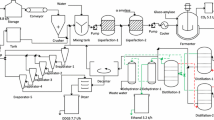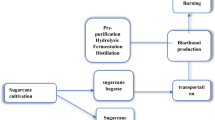Abstract
In cassava ethanol studies, few studies have combined production data from plants with simulation models, and further investigated the environmental emissions caused by different production processes. In this paper, based on the survey data of cassava ethanol plants in Guangxi, we established an ethanol production process model and conducted a life cycle assessment of the raw meal fermentation (RMF) process and traditional clinker fermentation (CF) process. The impact of fermentation broth alcohol concentration on the environmental emissions of the whole process was also investigated based on the conventional CF process. The results showed that the RMF production process had more advantages than the CF production process in terms of energy savings, with 633 MJ per ton of ethanol and 37.39 kg eq/t ethanol of CO2 reduction. Increasing the alcohol concentration of the fermentation broth facilitated the removal of environmental emissions from the process. All cassava ethanol production models exhibited net energy ratios of no less than 2.74. Of these, the RMF 15% showed the most competitive net energy ratio of 2.97, the highest renewability of 4.52, and the lowest environmental emissions. A detailed analysis of the environmental impacts by the ethanol production phase showed that the distillation section was the critical point for energy saving and emission reduction. Sensitivity analysis showed that fertilizer and natural gas consumption could not be ignored.













Similar content being viewed by others
Data availability
Not applicable.
Abbreviations
- LCA:
-
Life cycle assessment
- RMF:
-
Raw meal fermentation
- CF:
-
Clinker fermentation
- CCS:
-
Carbon dioxide capture and storage
- GWP:
-
Global warming potential
- AP:
-
Acidification potential
- EP:
-
Eutrophication potential
- ODP:
-
Ozone layer depletion potential
- POCP:
-
Photochemical ozone generation potential
- HTP:
-
Human toxicity potential
- Ne:
-
Alcohol volume of fermentation broth
- E in :
-
Total net input energy
- E inf :
-
Total non-renewable energy input
- E out :
-
Total net output energy
- NEV:
-
Net energy value
- NER:
-
Net energy ratio
- NRnEV:
-
Net renewable energy value
References
Azad AK, Rasul MG, Khan MMK, Sharma SC, Hazrat MA (2015) Prospect of biofuels as an alternative transport fuel in Australia. Renew Sust Energ Rev 43:331–351
Garcia CA, Riegelhaupt E, Ghilardi A, Skutsch M, Islas J, Manzini F et al (2015) Sustainable bioenergy options for Mexico: GHG mitigation and costs. Renew Sust Energ Rev 43:545–552
Gheewala SH, Silalertruksa T, Nilsalab P, Mungkung R, Perret SR, Chaiyawannakarn N (2013) Implications of the biofuels policy mandate in Thailand on water: the case of bioethanol. Biores Technol 150:457–465
Valencia MJ, Cardona CA (2014) The Colombian biofuel supply chains: the assessment of current and promising scenarios based on environmental goals. Energy Policy 67:232–242
Zhang TT, Xie XM, Huang Z (2017) The policy recommendations on cassava ethanol in China: analyzed from the perspective of life cycle “2E & W.” Resour Conserv Recycl 126:12–24
Han DD, Yang XX, Li R, Wu YL (2019) Environmental impact comparison of typical and resource-efficient biomass fast pyrolysis systems based on LCA and Aspen Plus simulation. J Clean Prod 231:254–267
Liu BB, Wang F, Zhang B, Bi J (2013) Energy balance and GHG emissions of cassava-based fuel ethanol using different planting modes in China. Energy Policy 56:210–220
Sriroth K, Piyachomkwan K, Wanlapatit S, Nivitchanyong S (2010) The promise of a technology revolution in cassava bioethanol: from Thai practice to the world practice. Fuel 89(7):1333–1338
DA I Du YUS-r, Geng-qiang PU, Cheng-tao WANG (2006) E10 fuel life cycle assessment based on hybrid model. J Shanghai Jiaotong University 02: 355-358
Ding DJMHJFGTF (2019) Estimating the potential of energy saving and carbon emission mitigation of cassava-based fuel ethanol using life cycle assessment coupled with a biogeochemical process model. Int J Biometeorol 63:701–710
Wang CB, Malik A, Wang YF, Chang Y, Pang MY, Zhou DQ (2020) Understanding the resource-use and environmental impacts of bioethanol production in China based on a MRIO-based hybrid LCA model. Energy 203
Parascanu MM, Sanchez N, Sandoval-Salas F, Carreto CM, Soreanu G, Sanchez-Silva L (2021) Environmental and economic analysis of bioethanol production from sugarcane molasses and agave juice. Environ Sci Pollut R 28(45):64374–64393
Sandra Belboom BB (2015) Does the production of Belgian bioethanol fit with European requirements on GHG emissions? Case of wheat. Science Direct 74:58–65
Rathnayake M, Chaireongsirikul T, Svangariyaskul A, Lawtrakul L, Toochinda P (2018) Process simulation based life cycle assessment for bioethanol production from cassava, cane molasses, and rice straw. J Clean Prod 190:24–35
Yu SR, Tao J (2009) Economic, energy and environmental evaluations of biomass-based fuel ethanol projects based on life cycle assessment and simulation. Appl Energy 86:S178–S188
Ou XM, Zhang XL, Chang SY, Guo QF (2009) Energy consumption and GHG emissions of six biofuel pathways by LCA in (the) People’s Republic of China. Appl Energy 86:S197–S208
Lyu HS, Zhang J, Zhai ZW, Feng YX, Geng ZF (2020) Life cycle assessment for bioethanol production from whole plant cassava by integrated process. J Clean Prod. 269:88–97
Nitayavardhana S, Shrestha P, Rasmussen ML, Lamsal BP, van Leeuwen J, Khanal SK (2010) Ultrasound improved ethanol fermentation from cassava chips in cassava-based ethanol plants. Biores Technol 101(8):2741–2747
Poonsrisawat A, Paemanee A, Wanlapatit S, Piyachomkwan K, Eurwilaichitr L, Champreda V (2017) Simultaneous saccharification and viscosity reduction of cassava pulp using a multi-component starch- and cell-wall degrading enzyme for bioethanol production. 3 Biotech 7
Li Z (2010) Problems and solutions of energy saving and consumption reduction in cassava ethanol fermentation industry in china. LIQUOR-MAKING SCIENCE & TECHNOLOGY 2:121–124. https://doi.org/10.13746/j.njkj.2010.02.027
Luo Hu LY, Zhenjiang Sun, Liang Kunguo Xu, Wangfa Lai Mingxue (2018) Process optimization of cassava raw meal fermentation to produce fuel ethanol. Chinese J Biop Engineering 16:80–5
Yue Guojun SZ, Naijiang Shen (2015) Net energy analysis for annual 200 000 ton cassava ethanol production at Guangxi COFCO Chinese. J Biotech 31:242–50. https://doi.org/10.13345/j.cjb.140352
Neamhom T, Polprasert C, Englande AJ (2016) Ways that sugarcane industry can help reduce carbon emissions in Thailand. J Clean Prod 131:561–571
Moriizumi Y, Suksri P, Hondo H, Wake Y (2012) Effect of biogas utilization and plant co-location on life-cycle greenhouse gas emissions of cassava ethanol production. J Clean Prod 37:326–334
Jiraprasertwong A, Maitriwong K, Chavadej S (2019) Production of biogas from cassava wastewater using a three-stage upflow anaerobic sludge blanket (UASB) reactor. Renew Energ 130:191–205
Papong S, Malakul P (2010) Life-cycle energy and environmental analysis of bioethanol production from cassava in Thailand. Bioresource Technol 101:S112–S118
Veiga JPS, Valle TL, Feltran JC, Bizzo WA (2016) Characterization and productivity of cassava waste and its use as an energy source. Renew Energ 93:691–699
Nguyen TLT, Gheewala SH, Garivait S (2007) Energy balance and GHG-abatement cost of cassava utilization for fuel ethanol in Thailand. Energy Policy 35(9):4585–4596
Merino JBAHCPCN (2011) Life cycle assessment for bioethanol produced from cassava in Colombia. Produccion + Limpia 6(2)
Patrizi N, MB, Saladini F (2020) Sustainability assessment of biorefinery systems based on two food residues in Africa. Front Sustain Food Syst 4:56–67
Nguyen TH, Williams S, KP, (2017) Impact of ecosystem carbon stock change on greenhouse gas emissions and carbon payback periods of cassava-based ethanol in Vietnam. Biomass and Bioenergy 100:1–12
Salla DA, FPBF, Cabello C, Ricardo AD (2009) Kanthack Análise energética de sistemas de produção de etanol de mandioca (Manihot esculenta Crantz). Revista Brasileira deEngenharia Agrícola e Ambiental 4:444–448
Ohimain EI (2015) Environmental impacts of smallholder ethanol production from cassava feedstock for the replacement of kerosene household cooking fuel in Nigeria. Energy Sources 68:37–41
Funding
The authors would like to thank National Natural Science Foundation of China for their support of this project (No:52100210).
Author information
Authors and Affiliations
Contributions
All the authors contributed to the study conception and design. Material preparation, data collection, and analysis were performed by Lulu Zhan, Xi Zhang, Yizhen Zeng, Rui Li, Xianliang Song, and Bin Chen. The first draft of the manuscript was written by Lulu Zhan, and all the authors commented on previous versions of the manuscript. All the authors read and approved the final manuscript.
Corresponding authors
Ethics declarations
Ethical approval
Not applicable.
Competing interests
The authors declare no competing interests.
Additional information
Publisher's Note
Springer Nature remains neutral with regard to jurisdictional claims in published maps and institutional affiliations.
Supplementary Information
Below is the link to the electronic supplementary material.
Rights and permissions
Springer Nature or its licensor (e.g. a society or other partner) holds exclusive rights to this article under a publishing agreement with the author(s) or other rightsholder(s); author self-archiving of the accepted manuscript version of this article is solely governed by the terms of such publishing agreement and applicable law.
About this article
Cite this article
Zhan, L., Zhang, X., Zeng, Y. et al. Life cycle assessment of optimized cassava ethanol production process based on operating data from Guangxi factory in China. Biomass Conv. Bioref. (2022). https://doi.org/10.1007/s13399-022-03442-9
Received:
Revised:
Accepted:
Published:
DOI: https://doi.org/10.1007/s13399-022-03442-9




